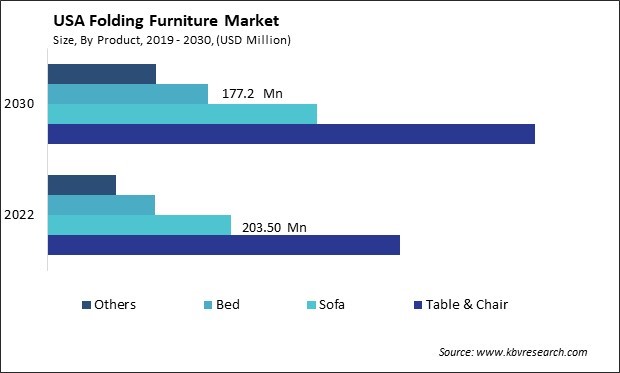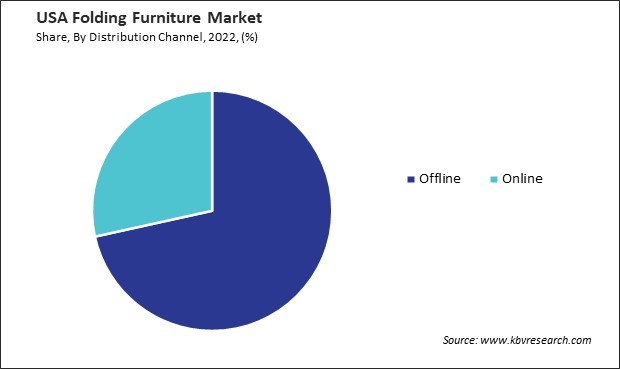USA Folding Furniture Market Size, Share & Trends Analysis Report By Product (Table & Chair, Sofa, Bed, and Others), By Distribution Channel (Offline, and Online), and Forecast, 2023 - 2030
Published Date : 22-Apr-2024 |
Pages: 68 |
Formats: PDF |
COVID-19 Impact on the US Folding Furniture Market
The USA Folding Furniture Market size is expected to reach $1.1 Billion by 2030, rising at a market growth of 4.8% CAGR during the forecast period. In the year 2022, the market attained a volume of 3833.8 thousand units, experiencing a growth of 5.0% (2019-2022).
The foldable furniture market in the United States has witnessed significant growth in recent years, driven by various factors such as urbanization, space constraints, and a rising trend toward versatile and multifunctional living spaces. Foldable furniture offers a practical solution for individuals and families seeking to optimize their living areas without compromising comfort or style.

U.S. consumers appreciate the ability to transform their living spaces quickly, whether for hosting guests, rearranging rooms, or simply creating more open spaces. This adaptability has positioned foldable furniture as a practical and stylish choice for today's dynamic living environments. Many foldable furniture designs prioritize eco-friendly materials and production processes, aligning with consumers' growing awareness of environmental concerns.
The impact of COVID-19 on the foldable furniture market has influenced consumers' purchasing behavior and strategies adopted by manufacturers and retailers. The emphasis on hygiene and safety has led to an increased focus on contactless delivery and virtual shopping experiences. Companies in the foldable furniture sector adapt to these changes by investing in user-friendly online platforms, augmented reality tools for virtual product visualization, and efficient logistics to meet the growing demand for their products.
Market Trends
Demand for folding furniture driven by urbanization
In the United States, the folding furniture market has witnessed a rapid surge in growth, fueled primarily by the ongoing trend of urbanization. As urban areas expand and populations concentrate in metropolitan regions, the demand for versatile and space-efficient furniture solutions has intensified. This shift is driven by the inherent space constraints in urban dwellings, where maximizing usable space has become a priority for many residents.
One of the key factors contributing to the rise of folding furniture in the U.S. is the increasing number of small-sized apartments and homes in urban centers. With limited square footage, consumers actively seek furniture that can be easily folded and stored when not in use, allowing for a more efficient use of their living space. This has led to a growing preference for foldable tables, chairs, and storage units that offer functionality and flexibility.
Additionally, the U.S. population's changing demographics and lifestyle preferences play a significant role in shaping the folding furniture market. The rise of single-person households and the trend towards minimalistic living have created a demand for furniture that adapts to diverse spatial requirements. Foldable furniture not only addresses the need for space optimization but also aligns with the contemporary aesthetic preferences of modern urban dwellers.
According to the U.S. Census Bureau, the surge in urban growth has led to a notable increase in population density within urban areas, rising from an average of 2,343 in 2010 to 2,553 in 2020. This shift in urban dynamics has also resulted in changes to housing unit qualifications, with 225 urban areas meeting the 2020 housing unit threshold that would not have qualified based solely on the new population threshold. This transformation in urban landscapes has sparked a growing demand for folding furniture in the United States, as the need for versatile and space-efficient solutions becomes more pronounced in response to the densification of urban living spaces. Thus, the surge in the U.S. folding furniture market is propelled by urbanization, small living spaces, and changing demographics.
Advances in design and functionality in the United States
In recent years, the folding furniture market in the United States has experienced significant advances in design and functionality, catering to the evolving needs of consumers in a dynamic and space-conscious society. This industry has undergone a transformative shift driven by technological innovations, changing lifestyles, and a growing emphasis on multifunctionality. Customization options have become a driving force in the U.S. folding furniture market, as consumers seek personalized solutions that fit their specific needs and preferences. From modular shelving units to customizable folding tables, the industry is witnessing a shift towards made-to-order and adaptable designs that cater to individual spatial constraints.
Functionality has become a key focus, with furniture designers incorporating versatile features to meet the demands of diverse living spaces. Folding sofas with built-in storage compartments, modular wall units that transform into workspaces, and collapsible dining sets are just a few examples of the innovative solutions emerging in the U.S. industry. Manufacturers are leveraging cutting-edge materials and technologies to create products that save space and enhance the overall user experience. For instance, folding tables and chairs now have sensors and connectivity features, allowing users to customize settings or monitor usage patterns through smartphone apps. Hence, the U.S. folding furniture market has undergone a transformative shift, driven by technological innovations and a focus on customization to meet the evolving needs of space-conscious consumers.

Competition Analysis
The folding furniture market in the United States has witnessed significant growth, driven by the increasing demand for space-efficient and versatile solutions in residential and commercial spaces. One of the prominent players in the folding furniture market is Cosco. With a history spanning several decades, Cosco has established itself as a trusted brand known for its commitment to quality and functionality. The company specializes in various folding furniture, including tables and chairs. Their folding chairs and tables are popular choices for events, parties, and gatherings, offering a balance of durability and affordability.
Lifetime Products is another major contributor to the folding furniture market in the United States. The company is recognized for its innovative approach to design and manufacturing. Lifetime Products offers a diverse range of folding furniture, emphasizing durability and longevity. Many of their products feature materials like high-density polyethylene, providing resistance to wear and tear. The brand's folding tables and chairs find applications in various settings, from professional events to outdoor activities, meeting the demands of consumers seeking reliable and versatile furniture solutions.
Flash Furniture is a noteworthy player known for its commitment to affordability and style in the folding furniture market. The company offers various folding furniture options, including chairs and tables, with contemporary designs that appeal to a broad consumer base. Flash Furniture's products often feature lightweight materials, making them easily portable and suitable for indoor and outdoor use. The brand's focus on blending functionality with modern aesthetics has contributed to its popularity in the industry.
In recent years, emerging players like Furinno have gained recognition for emphasizing compact and budget-friendly folding furniture. Furinno's products are designed with simplicity and practicality, making them suitable for smaller living spaces. The brand often utilizes eco-friendly materials, aligning with consumer interest in sustainable and responsible manufacturing practices.
Local manufacturers, such as McCourt Manufacturing, contribute significantly to the folding furniture market, particularly in the commercial sector. McCourt manufactures folding tables and seating solutions for events, conferences, and hospitality. The company's products are known for their durability and ease of use, meeting the demands of professional environments where quick setup and breakdown are crucial. As consumers increasingly prioritize flexibility and efficiency in their living spaces, the market is poised for continued growth and evolution, with companies striving to meet the dynamic demands of a discerning consumer base.
List of Key Companies Profiled
- Sauder woodworking Co.
- Ashley Furniture Industries, LLC
- Haworth, Inc.
- Lifetime Products
- Expand Furniture Inc
- Murphy Wall Beds Hardware Inc.
- Resource Furniture
- Inter IKEA Systems B.V. (Inter IKEA Holding B.V.)
- Meco Corporation (Unaka Corporation)
- Dorel Industries, Inc.
US Folding Furniture Market Report Segmentation
By Product
- Table & Chair
- Sofa
- Bed
- Others
By Distribution Channel
- Offline
- Online
1.1 Market Definition
1.2 Objectives
1.3 Market Scope
1.4 Segmentation
1.4.1 US Folding Furniture Market, by Product
1.4.2 US Folding Furniture Market, by Distribution Channel
1.5 Methodology for the research
Chapter 2. Market Overview
2.1 Introduction
2.1.1 Overview
2.1.1.1 Market Composition and Scenario
2.2 Key Factors Impacting the Market
2.2.1 Market Drivers
2.2.2 Market Opportunities
2.2.3 Market Restraints
2.2.4 Market Challenges
2.2.5 Market Trends
2.3 Porter’s Five Forces Analysis
Chapter 3. US Folding Furniture Market
3.1 US Folding Furniture Market by Product
3.2 US Folding Furniture Market by Distribution Channel
Chapter 4. Company Profiles – Global Leaders
4.1 Sauder woodworking Co.
4.1.1 Company Overview
4.1.2 SWOT Analysis
4.2 Ashley Furniture Industries, LLC
4.2.1 Company Overview
4.2.2 SWOT Analysis
4.3 Haworth, Inc.
4.3.1 Company Overview
4.3.2 SWOT Analysis
4.4 Lifetime Products
4.4.1 Company Overview
4.4.2 Recent strategies and developments:
4.4.2.1 Partnerships, Collaborations, and Agreements:
4.4.3 SWOT Analysis
4.5 Expand Furniture Inc
4.5.1 Company Overview
4.5.2 SWOT Analysis
4.6 Murphy Wall Beds Hardware Inc.
4.6.1 Company Overview
4.6.2 SWOT Analysis
4.7 Resource Furniture
4.7.1 Company Overview
4.7.2 Recent strategies and developments:
4.7.2.1 Product Launches and Product Expansions:
4.7.3 SWOT Analysis
4.8 Inter IKEA Systems B.V. (Inter IKEA Holding B.V.)
4.8.1 Company Overview
4.8.2 Financial Analysis
4.8.3 Regional Analysis
4.8.4 Recent strategies and developments:
4.8.4.1 Product Launches and Product Expansions:
4.8.5 SWOT Analysis
4.9 Meco Corporation (Unaka Corporation)
4.9.1 Company Overview
4.9.2 SWOT Analysis
4.10. Dorel Industries, Inc.
4.10.1 Company Overview
4.10.2 Financial Analysis
4.10.3 Segmental and Regional Analysis
4.10.4 Research & Development Expense
4.10.5 SWOT Analysis
TABLE 2 US Folding Furniture Market, 2023 - 2030, USD Million
TABLE 3 US Folding Furniture Market, 2019 - 2022, ThoUSnd Units
TABLE 4 US Folding Furniture Market, 2023 - 2030, ThoUSnd Units
TABLE 5 US Folding Furniture Market by Product, 2019 - 2022, USD Million
TABLE 6 US Folding Furniture Market by Product, 2023 - 2030, USD Million
TABLE 7 US Folding Furniture Market by Product, 2019 - 2022, ThoUSnd Units
TABLE 8 US Folding Furniture Market by Product, 2023 - 2030, ThoUSnd Units
TABLE 9 US Folding Furniture Market by Distribution Channel, 2019 - 2022, USD Million
TABLE 10 US Folding Furniture Market by Distribution Channel, 2023 - 2030, USD Million
TABLE 11 US Folding Furniture Market by Distribution Channel, 2019 - 2022, ThoUSnd Units
TABLE 12 US Folding Furniture Market by Distribution Channel, 2023 - 2030, ThoUSnd Units
TABLE 13 Key Information – Sauder woodworking co.
TABLE 14 Key Information - Ashley Furniture Industries, LLC
TABLE 15 Key Information – Haworth, Inc.
TABLE 16 Key Information – Lifetime products
TABLE 17 Key Information – Expand Furniture Inc
TABLE 18 Key Information – Murphy Wall Beds Hardware Inc.
TABLE 19 Key Information – Resource Furniture
TABLE 20 Key information – Inter IKEA Systems B.V.
TABLE 21 Key information – Meco Corporation
TABLE 22 Key Information – Dorel Industries, Inc.
List of Figures
FIG 1 Methodology for the research
FIG 2 US Folding Furniture Market, 2019 - 2030, USD Million
FIG 3 Key Factors Impacting Folding Furniture Market
FIG 4 Porter’s Five Forces Analysis - Folding Furniture Market
FIG 5 US Folding Furniture Market share by Product, 2022
FIG 6 US Folding Furniture Market share by Product, 2030
FIG 7 US Folding Furniture Market by Product, 2019 - 2030, USD Million
FIG 8 US Folding Furniture Market share by Distribution Channel, 2022
FIG 9 US Folding Furniture Market share by Distribution Channel, 2030
FIG 10 US Folding Furniture Market by Distribution Channel, 2019 - 2030, USD Million
FIG 11 SWOT Analysis: Sauder woodworking Co.
FIG 12 SWOT Analysis: Ashley Furniture Industries, LLC
FIG 13 SWOT Analysis: Haworth, Inc.
FIG 14 SWOT Analysis: Lifetime Products
FIG 15 SWOT Analysis: Expand Furniture Inc
FIG 16 SWOT Analysis: Murphy Wall Beds Hardware Inc.
FIG 17 SWOT Analysis: Resource Furniture
FIG 18 SWOT Analysis: Inter IKEA Systems B.V.
FIG 19 SWOT Analysis: Meco Corporation
FIG 20 SWOT Analysis: Dorel Industries, Inc.